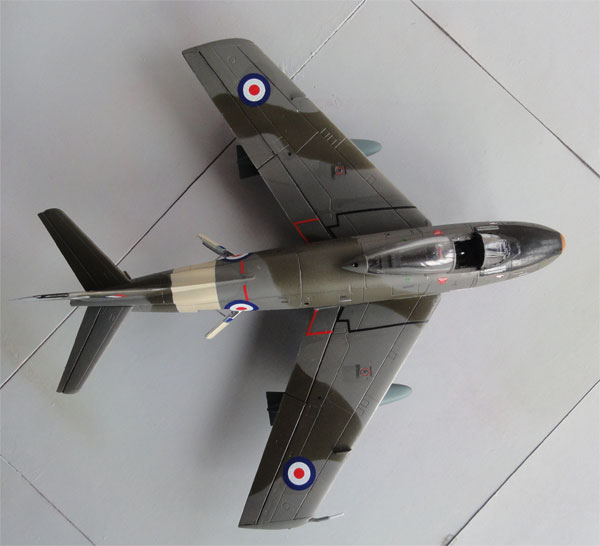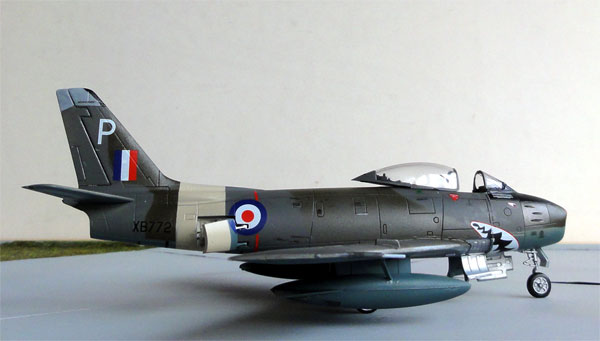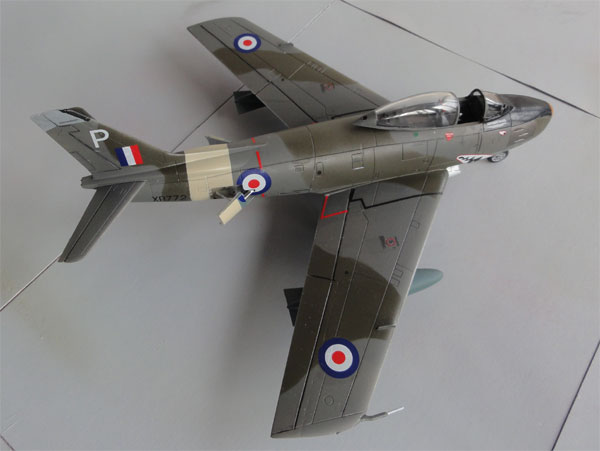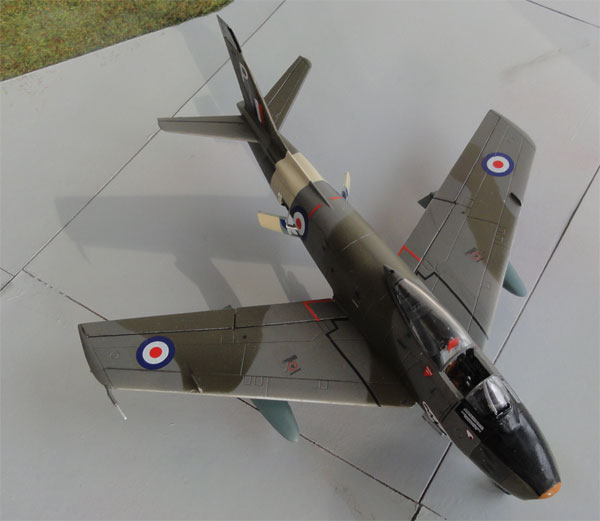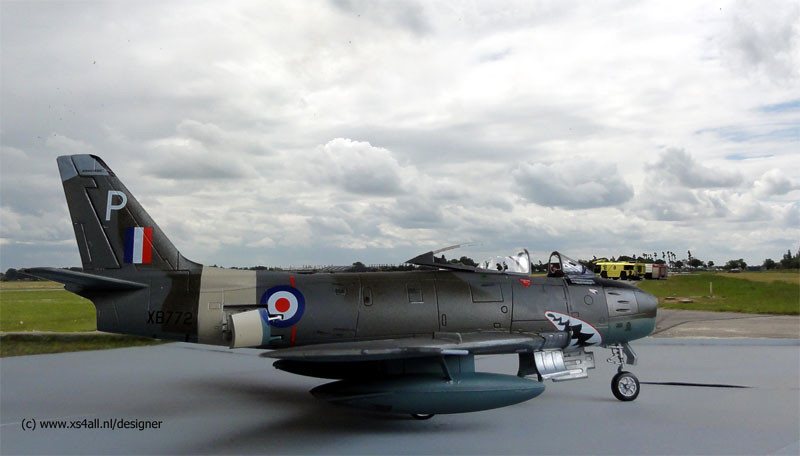Sabres, Dogs and "Kaasjagers"
F-86 Sabre in 1/72 scale: kit modelling reports
page 2
page 3
page 4
page 5
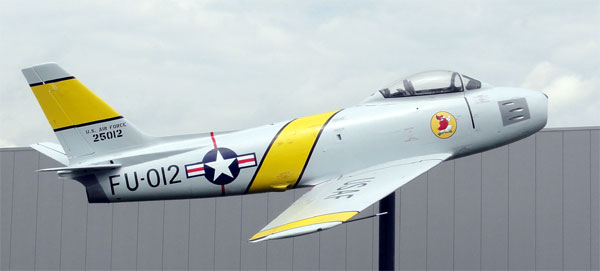
(Sabre at a pole, which I photographed at the Dutch Airfield at Teuge in 2010)
The F-86 Sabre was also the first American jet fighter with a swept wing. After the second world war, using German experimental data and seeing the German high speed aircraft designs such as those of Messerschmitt, the swept wing was the solution to air compressibility challenges that blocked aircraft flying faster. Sabres were used in the Korea war.
Of the Sabre, several variants were developed. Here the high lights:
The F-86A was the first introduced in 1948 with the swept slatted wing. It had the T-4E-1 ejection seat and rounded wind screen. Early jets had sealing doors over the 6 Browning machine guns, these doors were later deleted. Some modifications were done later with another V-shaped wind screen and gunsights and repositioned pitot tube.
The F-86D Sabredog got a much fatter fuselage with radar nose and a larger tail. It had no guns but a retractable rocket pod below the fuselage in front of the wing to attack enemy bombers. It had the slatted wing, all flying tail and later the upward opening "clamshell" canopy. It flew in 1950 and the F-86D was further refined over the years with systems and powered rudder and dropable wing fuel tanks and other wind screen. The electronics were top secret.
The F-86E was an improved day fighter with an all flying tail. It was hard to distinguish from the F-86A but had a thicker fairing below the vertical tail. It got from block E-10 a flat wind screen.
The first F-86F got another J47-GE-27 engine but the first jets were similar to the -E. But new wings were introduced that also could carry drop tanks. The F86F-10 got radar ranging with another gun sight and the F-86F-15 got control modifications.
From the F-86F-25 onwards such as on F-86F-30, F-86F-35: the bigger "6-3" non-slatted wing was introduced with an extra inboard pylon station. The root chord was extended 6 inch and the wing tip 3 inch. It had the slats were removed and extra fuel capacity in the forward wing sections. It had a small wing fence added to delay buffeting. Many old slatted F-86F blocks got the 6-3 non-slatted wing retrofitted which greatly improved performance (as proved in the Korea war).
Some F-86F-30 were fitted with recon cameras and designated RF-86F-30. It had the non-slatted F-30 "6-3" wing.
The F-86F-35-NA was similar as the F-86F-25 but had a low altitude bombing system (LABS) to drop a mark 12 atom bomb. Some 264 were manufactured and many deployed to Europe.
The F-86F-40 had the 6-3 wing but got a one feet tip extension and indeed again the slats fitted for better low speed handling (with the small fence removed). It was a modification for the Japan Air Self Defense Force. First delivery started October 1955. Mitsubishi license build the F-86F-40 in Japan. Later on the JASDF Sabres could also fire the first generation Sidewinder missiles. And some 280 F-86F-40 were manufactured for the USAF at North American and many F-40 wing kits to retrofit these to most of the active USAF F-86F fleet.
(NOTE: so the same jet can be seen with different wing depending on the date).
The F-86H was a version with the J73 engine with an larger intake and 6inch extra fuselage height and larger tail pipe and vertical fin. It had another F-86D like canopy and otrher ejection seat. It could fly bombing missions with four pylons and the LABS system. The F-86H-1 had six Browning machine guns and the wing was the slatted or the 6-3 wing. The F-86H-5 had 4 M39 canons. The F-86H-10 was very similar but with other wiring and better J73 engine. Some had the "F-40" wing with slats.
The F-86K "Kilo"
was a development of the F-86D with four 20mm cannons, improved electronics
with the simpler MG-4 system. (The F-86D had sensitive systems and was
only later released for export). These cannons required that the fuselage
of the F-86K was stretched 8 inches. It had an upward tilted opening canopy. The first F-86K was delivered in 1955
to especially European NATO countries including 63 planes for the Royal
Netherlands Air Force. It was called in Dutch the "Kaasjager" and many
were licensed built from North American by the Italian FIAT company.

Two wing types
were used on the F-86K: initially when introduced the wing was similar as on the F-86D. Later starting in 1960,
many Sabres got a larger "F-40" slatted wing including the modernized F-86F-40
and F-86K and two extra pylons to fire Sidewinders.
The Dutch
F-86K when delivered had the small slatted wing, but later beginning 1960 got the
modification with a larger "F-40" wing;
For the F-86K,
in 1961 the PHILCO-FORD / RAYTHEON GAR-8 ( later called AIM-9B Sidewinder)
missile capability was added as well with 2 extra pylons and electronics.
When making
a model of a Dutch F-86K one can thus pick an early type "F-30" wing or
a later type "F-40" wing.
All F-86L were converted F-86D jets to "K" but with the F-40 slatted wing with extended wing tip. Over 900 jets were converted with service entry 1957.
---------------
In Canada the F-86 was license manufactured by Canadair designated CL-13. The CL-13 mk.4 was also used by the British RAF as F-4.
In Australia by the Commonwealth Aircraft Corporation (CAC) 2 versions of the F-86F were license manufactured. The CA-27 got a complete redesign to fit the Rolls Royce Avon engine to in the fuselage. It had "higher" air intake and fatter fuselage. Also Aden 30mm guns were installed and Sidewinder missiles could be fired. The CA-27 mk.30 had the slatted wing, the mk.31 the 6-3 non slatted wing and the mk.32 had 4 wing pulons and Avon 26 engine.
![]()
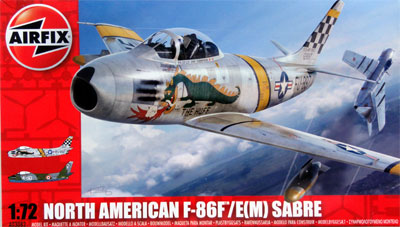
Airfix issued a brand new 1/72 scale kit of the F-86 F/E(M) Sabre in 2010 and it is a simple, cheap and good kit (no. A03082). Although not having all the finesses seen in many other kits nowadays, the basics are all there and the result will be quite good. It has the 6-3 wing without leading edge slats. (many F-86F got this wing retrofitted).
Also, the decals are excellent with
markings for...
[A] the well known USAF F-86F "The
Huff" of 39th FIS at Korea in a metal scheme.
[B] an Italian F-86E Sabre of 4th
Storno of the year 1958 with a NATO camouflage scheme.

The kit was also issued
by Airfix in another box (no. A03083) for a Canadair F-86 Sabre F.4
with different decals:
[C] Canadair Sabre F.4 No.112
Squadron, Royal Air Force Germany, during exercise "Carte Blanche", Geilenkirchen,
Germany, June 1955
[D] F-86E(M) Sabre Jugoslovensko
Ratno Vazduhoplovstvo of the Yugoslavian Air Foce, 1965.
NOTE: I could not verify what exactly is a F-86E(M).
For both issued kits parts are almost the same:
- it has the non-slatted "6-3" wing with wing fence and kinked pitot tube.
- looking at the ailerons, the aileron chords are far too wide. Filling the panel line
and rescribing the aileron leading edge panel line 1 mm more towards the
trailing edge solves this. But the aileron leading edge should still show "a step".
- the number of parts is about 60
with a nice touch the option to set open the gun ammunition load doors
with pilot step.
- nice recessed panellines although
there are not that many of these.
- the cockpit could be detailed a
bit more, inserting a better seat or an after market seat would be a simple
but good improvement.
- there is not a very deep intake
tunnel, but it is sufficient. I simply painted the rear inside end black.
For the rest, it is a very simple kit. The indicated build sequence can be followed, so starting with cockpit, next the fuselage, wings and so on. Only minor filler was needed in some places.
![]()
The first kit will be made as a Royal
Air Force Sabre F.4 model.
Below the filled too wide ailerons
are filled and rescribed:
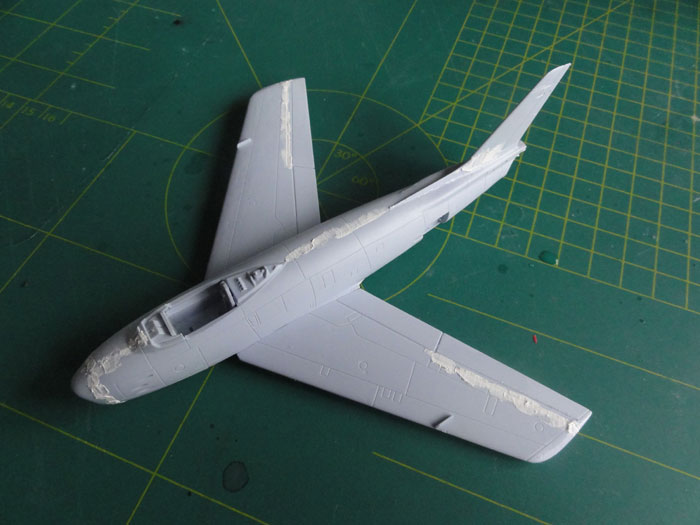
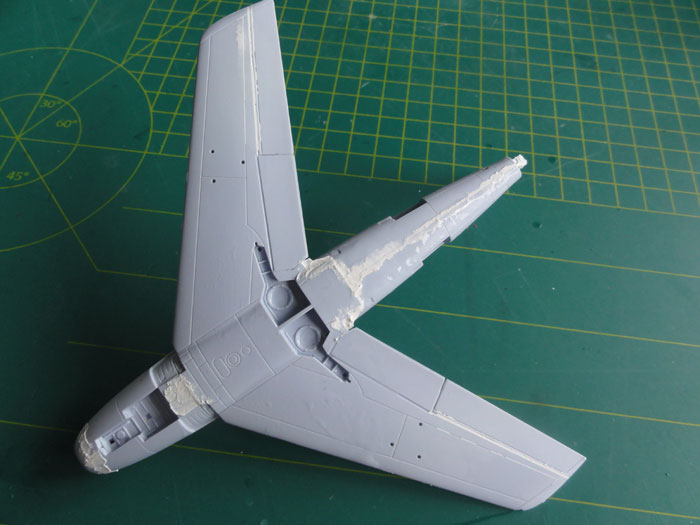
The filler used here is white Alabastine
car
filler but any filler will do.
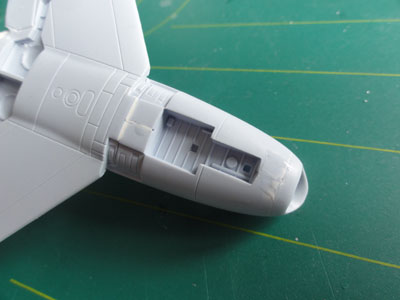 .
.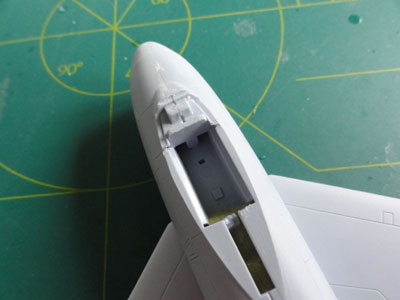
Below the rescribed aileron edges
can be seen...
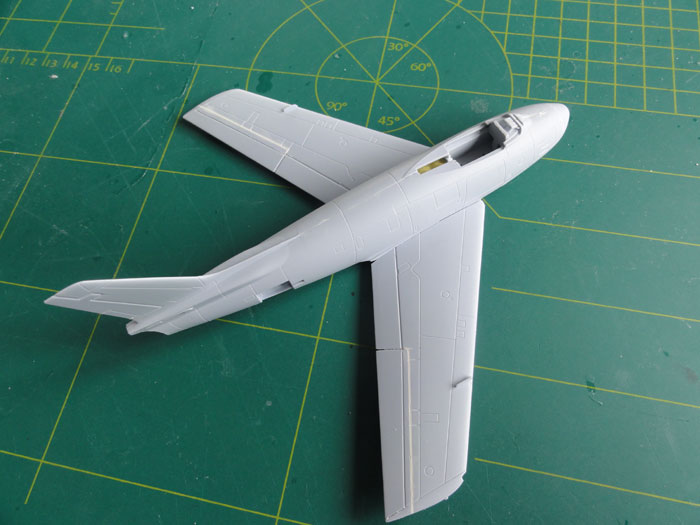
After filling, drying and sanding,
the model could quickly be given a first base light grey coat to check
for any flaws.
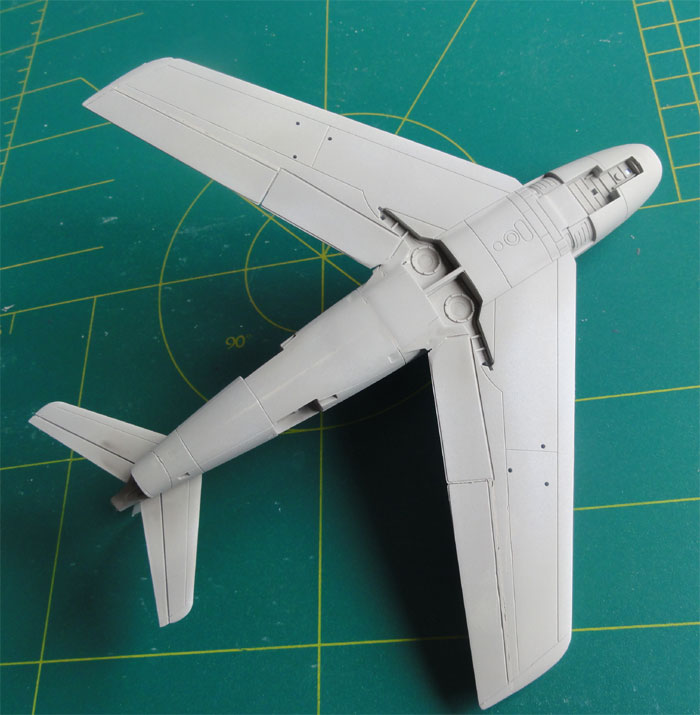
.. and upper view, note the re-scribed
aileron edges.
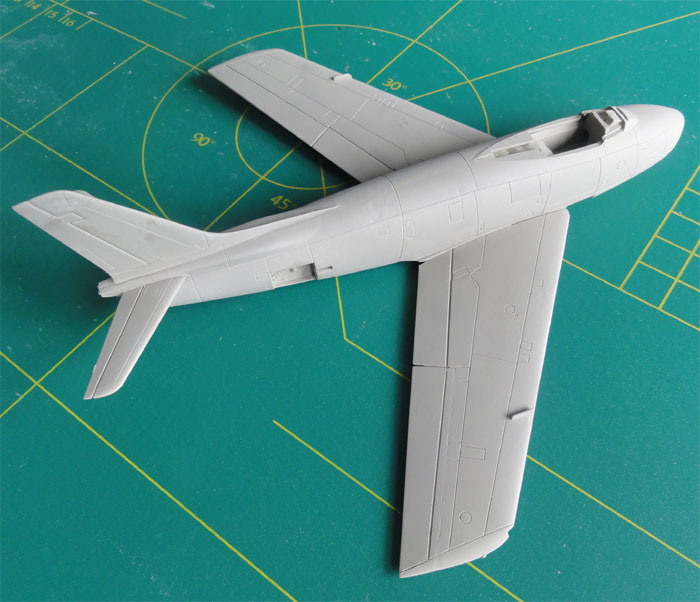
![]()
For the colour scheme, it was decided
to do a standard European NATO camouflage scheme Sabre. (many metal coloured
F-86 Sabre older models already being in the collection modelling the old
Matchbox kit, Heller kits and the much better Fujimi kits still in the
stash).
The NATO camouflage colours of the
nineteen fifties and sixties are usually...
Dark green FS 22662
Dark sea grey FS 22090
PRU blue undersides FS 22602
(note that other NATO air forces often have light grey or natural metal
undersides).
In my enamel paints box, I found the old HUMBROL "authentic colours" HX1 Dark green, HX2 Dark sea grey and HX3 PRU Blue. I suggest otherwise using Humbrol respectively HU163, HU125 and HU124.
First, the PRU blue was airbrushed on the under surfaces. After at least 48 hours drying time is needed for the old enamel, masking was done on the PRU blue with low tack tape of TAMIYA.
Next, it was time for the camouflage. I started first be sprayed the upper surfaces a coat of Dark sea grey. After again 48 hours drying time, masking was needed for the Dark green.
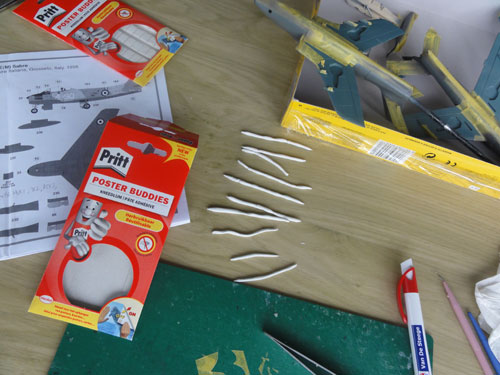
In order to get soft demarcation
camouflage patterns, on 1/72 scale, PrittPoster
Buddies can be used. The use of poster buddies raises
the mask a bit above the surface, so when airbrushing you get a softer
edge.
It is a tacky material found in book
stores that is used to fix photos, papers etc. It can be rolled in long
strings. using the Modeldecal instructions, the camo pattern is known and
the strings fixed onto the model. The grey areas covered with paper and
tape and the model is ready to receive its third coat of Dark green.

and the result...
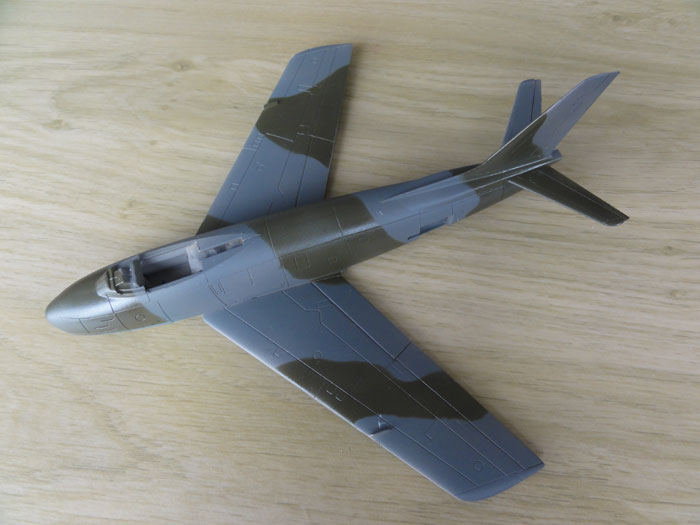
![]()
Now some detailling was needed in
the cockpit area. Some bits and pieces of plastic were used here.
The undercarriage bays are natural metal, as well as the gear legs and wheel hubs. Tyres are tyre black. The cockpit interior is medium gull grey with red seat head rest. The seat base and frame is grey.
The decals in the Airfix box (no. A03083) for a Canadair F-86 Sabre F.4 of No.112 Squadron, Royal Air Force Germany, during exercise "Carte Blanche", Geilenkirchen, Germany, June 1955, were picked for this model.
For the colour scheme, the standard
European NATO camouflage scheme was used here with Humbrol paints.
Dark green FS 22662
Dark sea grey FS 22090
PRU blue undersides FS 22602
(note that other NATO air forces often have light grey or natural metal
undersides).
Before applying the decals, a gloss coat with JOHNSON FUTURE/KLEER was applied with the airbrush.
The kit decals went on OK, but I had to take care of the roundel at the airbrake which was set opened up. It needs trimming in a few bits.
Final touches were:
- fin tip was painted medium grey
- making a small hole in the rear
canopy fairing
- adding pitot tube
- the undercarriage
- set the opened airbrakes
This model sits nicely in the RAF collection in 1/72 scale.
For
a 1/72 scale F-86K on to [ Page 2.... ]
Reference books:
- F-86 Sabre in Detail and Scale, Bert Kinzey, USA
- F-86 Sabre in Action, Larry Davis, Squadron Signal publications no. 126, USA
- F-86 Sabre Modern combat aircraft, Ian Allan, UK
- F-86 Sabre in colour, Squadron signal publications, USA
- F-86 Koku Fan no.39, and no.107, Bunrin Do, Japan
F-86K publications IPMS Nederland: MIP 1978-2 , MIP 1983-1 , MIP 1984-4 , MIP 2002-3 , MIP 2002-4, MIP 2007-1 .
Dutch Air Force enthusiasts can see RNeth AF information F-86K "Kaasjager" at the IPMS NL site
Back to 1/72 Models
(c) Copyright "designer"/ All rights reserved. Your comments are welcomed by webmaster
Created this page
November 14, 2011
